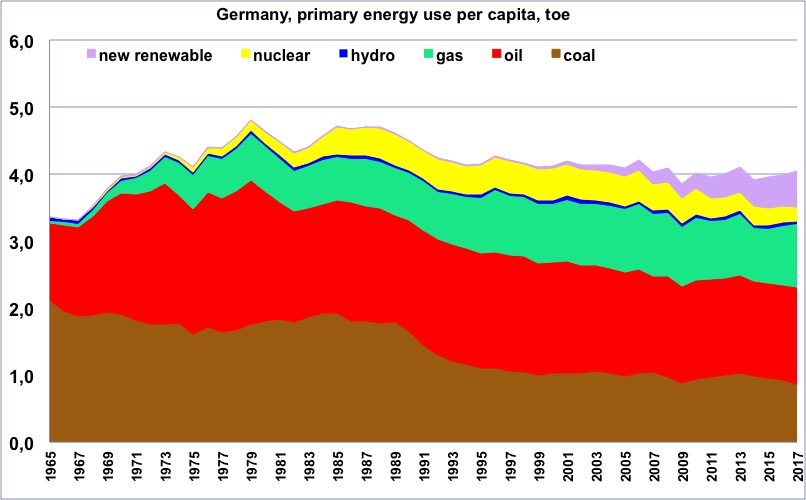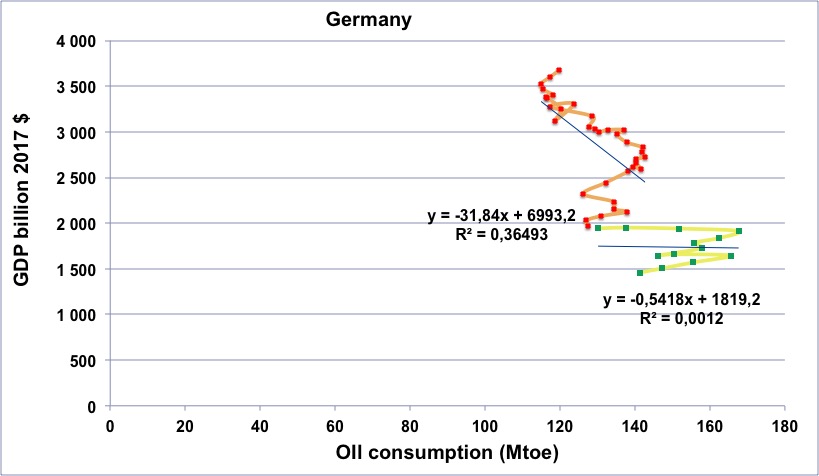
Primary energy consumption in Germany, wood excluded, from 1965, in million tons oil equivalent.
(one ton oil equivalent = 11600 kWh).
One will notice the constant decrease after the second oil shock, and the spectacular decrease of coal after the reunification (1990).
One will also notice that for the time being renewables are far from representing the bulk of Germany’s supply! “New Renewable” = all renewable energies except wood and hydroelectricity.
Author’s compilation on primary data from BP Statistical Review, 2015

Same as before, but with one curve per energy.
One will notice that oil started declining in the mid-90’s, and nuclear in 2006 (that is 5 years before Fukushima), and gas in 2006.
Author’s compilation on primary data from BP Statistical Review, 2015

Same as before, but with a curve that totals all “non fossil” production (“non fossil” is anything except coal, gas and oil, and is therefore the sum of nuclear and renewables).
One will notice that this term is almost stable since 2006, which raises the question of what is substituted by the rise of “new renewables”.
Author’s compilation on primary data from BP Statistical Review, 2015

Primary energy consumption per capita in Germany, wood excluded, from 1965, in tons oil equivalent
(one ton oil equivalent = 11600 kWh).
One will notice that the maximum happened in 1979. “New Renewable” = all renewable energies except wood and hydroelectricity.
Author’s compilation on primary data from BP Statistical Review, 2015

Same as before, but with one curve per energy.
Author’s compilation on primary data from BP Statistical Review & World Bank, 2015

Share of each energy (wood excluded) in the German consumption since 1965, and share of the fossil fuels.
One will notice that the share of gas and coal have been almost stable for the last 10 years, and that the decrease of the share of fossil fuels is mostly due to the decline of oil, which is little used in electricity generation.
Author’s compilation on primary data from BP Statistical Review, 2015

Annual change of the primary energy consumption in Germany (wood excluded) since 1965.
In the long term, the growth rate has been declining, then has turned into a growing decline rate (for those that are not afraid, it means that the second derivative of the German energy consumption has been negative on average for the last 45 years).
Author’s compilation on primary data from BP Statistical Review, 2015

Annual change of coal consumption in Germany since 1965.
The long term trend is that of a continuous decline, at a constant pace, even though the trend from 1990 to 2014 is rather the opposite.
Author’s compilation on primary data from BP Statistical Review, 2015

Annual change of the oil consumption in Germany since 1965.
As for energy as a whole, we have turned from a declining growth rate to an increasing decline rate.
Author’s compilation on primary data from BP Statistical Review, 2015

Annual change of the gas consumption in Germany since 1965.
Author’s compilation on primary data from BP Statistical Review, 2015

Annual change of the “non fossil” (wood excluded) consumption in Germany since 1965.
One will notice that the growth rate of these “non fossil” energies is globally declining, (with an average around zero since 2006), which means that the “new renewables” (wind, photovoltaic, biogas, biofuels, geothermal, etc), which do increase, nevertheless fail to allow for a growth rate that was that of nuclear and hydro a couple of decades ago.
Author’s compilation on primary data from BP Statistical Review, 2015

CO2 emissions coming from fossil fuels in Germany since 1965, in million tonnes.
One will notice that the maximum happened just after the second oil shock, and most of the decrease since then is due to coal.
Author’s compilation on primary data from BP Statistical Review, 2015

CO2 emissions per capita coming from fossil fuels in Germany since 1965, in tonnes.
One will notice that the maximum happened just before the first oil shock.
Author’s compilation on primary data from BP Statistical Review & World Bank, 2015

Evolution of the energy efficiency of the German economy since 1970 (constant dollars of GDP per kWh of primary energy) (no data before 1970).
When the value is increasing, it means that the economy is becoming more efficient.
The present value is similar to what it is for France.
Author’s calculation on primary data from BP Statistical Review, 2015, and World Bank, 2015

CO2 efficiency of the German economy since 1970 (grams of CO2 per constant dollar of GDP) (no data before 1970).
When the value is decreasing, it means that the economy is emitting less CO2 per unit of GDP.
Author’s calculation on primary data from BP Statistical Review, 2015, and World Bank, 2015

For the 1970-2014 period, annual change of the German GDP (horizontal axis) vs. annual change of the German energy consumption.
The regression means that for a 1% growth rate of the GDP there is a 0,7% growth rate of the energy consumption.
NB: “decoupling” would mean that the dots would always be in the lower right part of the chart, what indeed happened for the country for a number of years, mostly because of the former East Germany.
Author’s calculation on primary data from BP Statistical Review, 2015, and World Bank, 2015

German energy consumption (horizontal axis) vs German GDP (in constant billion dollars) for the period going from 1970 to 2014 (the orange line begins in 1970, at the lower left, and then the dots follow a chronological order going roughly up).
The first part of the curve is usual among Western countries: more energy and more GDP, with two “turns to the left” in 1974 and 1979.
The curve after 1990 is much more unusual: more GDP and less (or no more) energy, which largely results from the reunification.
Author’s calculation on primary data from BP Statistical Review, 2015, and World Bank, 2015

German energy consumption (horizontal axis) vs German industrial output (in constant billion dollars) for the period going from 1970 to 2014 (the brown line begins in 1965, at the lower left, and then the dots follow a chronological order).
One will notice that the dots are “concentrated” in a relatively restricted area, with a pattern not found in other coutries.
Author’s calculation on primary data from BP Statistical Review, 2015, and World Bank, 2015

German oil consumption (horizontal axis) vs German GDP (in constant billion dollars) for the period going from 1970 to 2014.
Green dots with yellow line: 1970 to 1982.
Red dots with orange line: 1983 to 2014.
Over the period, Germany has more than doubled its GDP in spite of a decrease of its oil consumption, which is unusual among Western countries. But part of the GDP comes from exports (of cars, planes, machines) that need energy and oil elsewhere!
Author’s calculation on primary data from BP Statistical Review, 2015, and World Bank, 2015

Electricity generation in Germany from 1985 to 2014, in billion kWh.
Source: BP Statistical Review 2015

“Non fossil” electricity generation per capital in Germany since 1965.
“Geothermal biomass” gathers geothermal and electricity generation from biogas and wood (biogas represents the largest fraction). This “non fossil” generation represents a little over 40% of the total generation in Germany.
Author’s compilation on data from BP Statistical Review